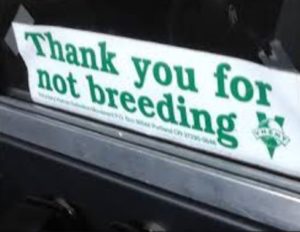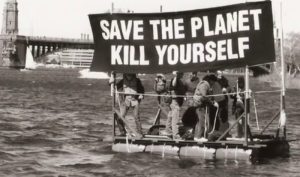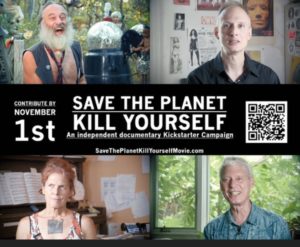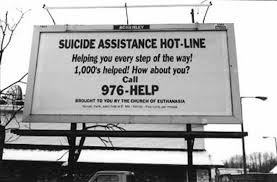CHURCH OF EUTHANASIA TIMELINE
1962: Chris Korda was born Christopher Korda in New York City.
1992: Korda reported being visited by “The Being” in a dream.
1992: The Church of Euthanasia was founded by Reverend Chris(tine) Korda and Pastor Kim (Robert Kimberk).
1994 (March 25): The CoE was incorporated in the state of Delaware.1994 (April 29): Korda’s “Save the Planet, Kill Yourself” musical recording was released.
1994 (June 1): The first issue of the CoE journal Snuff It was published.
1994 (September 10): CoE joined the first, and only, Boston Population Awareness Day.
1995: Korda and Lydia Eccles jointly formed a political action committee, Unabomber for President (UNAPACK).
1995 (August 22): The IRS awarded CoE 501(c)(3) tax-exempt status.
1995 (September 23): The CoE hosted a table at the Hemp Rally on the Boston Common.
1995 (October): CoE held its first, and only, “religious service” in the new CoE chapel, constructed in Sister Catherine’s basement.
1995 (December 1): CoE posted a Suicide Assistance Hotline number on a billboard in Dorchester, Massachusetts, but the hotline number was blocked by the telephone company.
1996 (February 17): Lydia Eccles lead Unabomber supporters at the New Hampshire Primary, while the performance artist Vermin Supreme organized a tour of the victory/defeat parties.
2015: The CoE website remained available on the internet but the organization had become inactive.
2015: Stephen Onderick, an independent filmmaker generated funding to begin creating a documentary on the group.
FOUNDER/GROUP HISTORY
The Church of Euthanasia can accurately be described as an anti-natalist organizations. While its symbolic protest activities are inspired by the “irrationalist, nonsensical, anti-capitalist 20th century art movement of Dadaism,” it is only one of a set of contemporary organizations with similar objectives. For example, the Right to Die movement traces at least to 1980 and the Hemlock Society (which later became Compassion and Choices). The Voluntary Human Extinction Movement, which was founded in 1991, proposes population control through voluntary measures as the only realistic strategy for humanity. The amorphous, more radical Gaia Liberation front proposes developing “genetically engineered viruses” to eradicate the human population (Broder 1996; Torres and Rees 2017).

The leader of the Church of Euthanasia, Chris Korda, was born as Christopher Korda in 1962 in New York City. [Image at right] Korda’s father is well-known novelist and playright Michael Korda. Korda developed political interests from an early age, becoming a vegetarian at the age of ten out of concern for global warming (Davis 2015). Korda maintains an ambiguous gender identity. Broder (1996) observes that “Although neither transvestite nor transsexual, he often wears women’s clothes, since he does not have to adhere to a sex role. And there is a concept for it: “a transgendered person,” a person beyond gender.” This gender ambiguity is consistent with Korda’s more general opposition to conventional categorization: “My object is to destroy those categories as much as possible, to present people with information that can’t be assimilated and that doesn’t fit into their categories (Parenteau 1999). [In the numerous articles about and interviews with Koda both male and female nouns are used. In this profile we use s/he and Chris(tine) in referring to Koda]
Korda attended Hammonasset School a college preparatory institution noted for its visual arts and performing arts training programs. As a young teenager, Korda recalls having “had an extremely unusual personality” and feeling “entirely different, as if from another star.” He continuously resisted “all attempts “to break me, to make me function like everyone else” and for a time was a runaway (Broder 1996). S/he began crossdressing in 1991 and recalls that
In retrospect, I feel that crossdressing was the beginning of an attempt to restore balance within myself, in a psychological sense, specifically between my male and female polar opposites, but also between other aspects of myself (Parenteau 1999).
Musical talents and female impersonation provided Korda with enough money to live on Cape Cod during this period.
Subsequently, Korda forged a successful career as a computer software developer and music software developer, and s/he also became an active electronic/techno musician. In addition to computer development and music interests, Korda is a political activist who has at least symbolically linked a political agenda with religious organization.
Korda’s concern with gender identity is related to later spiritual/religious commitments. For Korda, gender issues fundamentally traced to gaining and maintaining balance as a human being (Parenteau 1999):
I believe, personally, that cross-dressing is the balancing of male and female aspects within a person, within a person’s psyche, within their soul, if you will. And everyone has these male and female aspects. I mean, in most cases, they are grossly out of balance due to the extreme gender socialization that we’re exposed to as children. Men are forced into extreme male gender roles, women are forced into extreme female gender roles.
Korda believes that resolving the gender balance issue was personally liberating as “it wasn’t until I became aware of my, what some people have called ‘gender dysphoria,’ or ‘gender uncomfortableness,’ that I really began to make any progress in my life, towards a real kind of balance.” Achieving personal balance allowed Koda to pursue a broader agenda: “’And it wasn’t until I began to balance myself, internally’, he said, ‘that I could have any hope of really becoming aware of the larger imbalances that surround me, and do anything about them’.” Becoming trangender was not a solution for Koda as “it’s a typically western, patriarchal, interventionist, invasive solution to a problem that could never be solved that way.” The ultimate objective is to “gender-bend, to occupy the space in between the genders all the time.”
At the age of thirty, Korda had a spiritual experience that led in the direction of establishing CoE with Robert Kimberk (Church of Euthanasia website n.d.a):
The church was inspired by a dream, in which [the founder] Reverend Chris Korda, encountered an alien intelligence known as The Being who speaks for the inhabitants of Earth in other dimensions. The Being warned that our planet’s ecosystem is failing, and that our leaders deny this. The Being asked why our leaders lie to us, and why so many of us believe these lies. Rev. Korda awoke from the dream moaning the Church’s infamous slogan, Save the Planet – Kill Yourself.
Korda later turned the full content of this encounter into a song, which was released on April 29, 1994. The song ends with the lyrics, “Why do your leaders lie to you? Why do so many of you believe these lies? Explain your strange customs. Why believe these lies? Save the planet. Kill yourself” (Korda 1999).
The church was mainly active during the 1990s to the early 2000s. Its protest campaigns were constructed around environmentalism, abortion rights, animal rights and were carried out through organized protest events, through music, and through an online publication called “Snuff It” (Davis 2015; Eccles and Korda 1997). Church activity began to diminish after 2000, although the reasons for this are not entirely clear. The church did face potential legal problems when a woman in Missouri committed suicide in 2003 allegedly using instructions posted on the CoE website. St. Louis Circuit Attorney Jennifer Joyce threatened to pursue charges of voluntary manslaughter and the felony of criminalized assisted suicide charges against the church, and the church’s website was temporarily be taken down (Shannon 2011; Davis 2015). Koda has been opaque about this. When asked whether there had been any follow-up by the court system, s/he stated that “if there had ever been any follow-up by the courts…I am unaware of any such activity, nor would I be disposed to comment on or discuss such an activity if it did in fact exist” (Davis 2015). It may also be the case that opposition to CoE became to intense and risky. Korda indicated as much after the Bio 2000 counter-protest in Boston, which was the last public demonstration by the group. Kora stated that “the protest organizers cut the cables to the group’s sound system and then proceeded to beat them up….”What we were doing was extremely dangerous,” Korda said. “I got tired not just of the hate and the death threats, of which I have boxes, but I got tired of nearly being beaten to death (Davis 2015). In any event, the church lost its 501©(3) as no funding was reported. At the same time, Korda has at various points insisted that s/he will persist:
The only reason I haven’t killed myself yet, and I’m not saying I won’t, is because I have hope that by continuing to do the work that I’m doing, I could make the difference. My church could be the one to make the difference. There’s no way to know that it couldn’t, so we’re staying the course. I’m steady at the helm, we’re going to continue on (St. Andrew and Korda 1995).
At present, at least, publication of Snuff It has ceased and church sponsored activities appear to have ended, although some members still maintain active blogs online (Davis 2015). Korda has largely dropped out of the news, with only a recent article, which described Korda as an ”activist, techno musician and software developer,” and reported on an innovative project developing 3D printing software Jackson 2017).Film producer Steve Onderick has begun creating a documentary on CoE, “Save the Planet, Kill Yourself,” relying on Kickstarter funding. The project exceeded its objective of $10,000, raising nearly $12,000 through this medium (Onderick n.d.). However, the film has yet to be released.
DOCTRINES/BELIEFS

The church’s anti-natalist doctrine consists of one unconditional commandment: “Thou Shalt not Procreate.” [Image at right] According to the church, the deepening of our global environmental crisis is due entirely to an ever-increasing human population. The human race is therefore the adversary of all of creation through human impact on climate change, water supply and reduction of biodiversity. Rather than work to encourage human activity towards more environmentally friendly alternatives, the church teaches that the only way to reverse the negative effects of human overpopulation is to work toward a massive, but voluntary, population decrease. The church position is that “even a major war or epidemic hardly dents the rate of growth, and modern wars have tremendous environmental consequences (Church of Euthanasia n.d.)” An epidemic or virus would leave behind a stronger, more adaptive species. Wars motivate both the winners and losers to repopulate their countries and often cause an increase of population with time. Further, mandatory population reductions are impractical as the church holds a strong moral position against taking the life of living beings. Therefore, only voluntary non-procreation will effectively and continuously reduce the human population sufficiently. Koda is quite adamant on this point: “humans are making a conscious choice to place their interests above the well-being of life, and this is not merely foolish or misguided, it is shameful and criminal. If humans are unable—for whatever reason—to exist in a way that supports life, then humans are unfit, and must be eliminated” (Korda n.d.) The church insists that any member who violates the non-procreation commandment is subject to excommunication, and some members have been excommunicated on this basis. For members who already have children, the pledge is to refrain from having additional children (Davis 2015).
In addition to the non-procreation commandment, there are four “pillars” of faith: suicide, abortion, cannibalism and sodomy. The commandment, of course, is mandatory; the four pillars are essentially means to the non-procreative end (Korda 1992, Parenteau 1999).

The CoE suicide pillar, has been actualized through advertising, protest events, and website instructions. The pillar is usually expressed through the maxim, “Save the Planet, Kill Yourself,” [Image at right]. At the same time Korda’s interpretation of this pillar has been more nuanced at various times. At one point he stated: “What I think it’s saying, and this is all interpretation, is that if you’re going to kill something, kill yourself. It’s not saying that you have to kill something, but if you’re going to kill something, don’t kill the planet (Andrew and Korda 1995). On another occasion he stated that “When a person is at the end of his rope and needs to kill, then it would simply be better if he were to kill himself instead of another person – or an animal. Moreover, “kill yourself” could also mean: kill your Self, become something else!” (Broder 1996).
Abortion is not regarded as desirable and is not encouraged as a birth control method. The church therefore supports abortion rights without encouraging abortions. However, since the mission of CoE is to prevent procreation, pregnancy confronts members with a stark, binary choice:
Abortion will be required for members of the Church to avoid excommunication. Any member of the Church who willingly or knowingly or unknowingly causes a pregnancy or allows themselves to become pregnant is faced with the choice between abortion and excommunication. It’s as simple as that (Andrew and Korda 1995).
The church provides resources on its website about abortion in the event that members find themselves facing this difficult situation.
Sodomy is defined broadly as any non-procreative sexual activity and so includes both masturbation and protected sex. In fact, the church supports consensual sexual activity that does not result in procreation.
The fourth pillar, Cannibalism, may be the most inflammatory, but is in reality a taboo-like boundary marker. The church advocates a strict vegetarian/vegan diet on the bases that non-human beings are to be equally valued and that meat-based diets are both economically unsustainable and environmentally degrading. Somewhat like the choice between abortion and excommunication, cannibalism would only become a possible choice if a member did not adhere to a vegetarian or vegan diet. There are, in fact, no reported instances of any church members actually consuming human flesh (Einstein and Korda n.d.).
RITUALS/PRACTICES
CoE does not resemble an established church and does not engage in traditional religious practices. Indeed, in the history of the church there has only been one reported “church service.” It was conducted in October 1995 in a member’s basement that had been converted into a makeshift chapel that featured a picture of Dr. Jack Kevorkian, who the movement regards as a saint (Broder 1996).
The activities conducted by CoE are protest movement activities understood to be in furtherance of ultimate values. The protest practices carried out by church members are intended to be sensational and offensive for a reason. They are in the Dada tradition (rejecting reason and logic in favor of non-sense and non-rationality) and so often have taken the form of performance art and street theater). There are numerous examples of these protest activities:
In 1993 CoE placed an enormous banner across an existing billboard along the Massachusetts Turnpike with the CoE motto: “SAVE THE PLANET KILL YOURSELF.”
In 1995, CoE’s suicide advocacy program began when the church placed a “Suicide Assistance Hot-Line” number on a billboard with the message: “Helping you every step of the way! Thousands helped! How about you?”
In 1995, Korda and Lydia Eccles jointly formed a political action committee, to support Unabomber (Ted Kaczynski) for President. Korda resonated with Kaczynski’s argument that industrial-technological society over-regulates individual conduct and erodes the potential for human freedom.
In 1996, a group led by Korda, unfurled a large Swastika banner at a primary election in Boston, held a pro-abortion rally at a fertility clinic, and confronted pro-life supporters at an abortion clinic.
In 1997, CoE held a memorial ceremony in honor of members of Heaven’s Gate.
In 1997, Coe appeared on a Jerry Springer Show titled “I Want to Join a Suicide Cult,” organized blindfolded “Cannibal Taste Tests” at local food markets.
In 1997, Coe tried to enter the city’s annual Walk for Life event to stage a “fetus barbeque.”
In 1998, Korda participated Law Society debate on euthanasia at Trinity College in Dublin, Ireland.
In 2000, CoE counter-protested the “Bio 2000″ biotechnology conference in Boston. Forty CoE members counter-demonstrated in favor of biotech that would lead to human extinction. Korda was physically assaulted at the event (Dig Staff and Steve Onderick 2015).
In 2001, CoE released a film, “I Like to Watch,” three months after the 9/11 attacks. Korda reportedly later stated that the film accurately portrayed Korda’s “”perverse fascination and sexual arousal” at the time the attacks were occurring, that “Politically, it felt good to see Americans dying for a change,” and that “In gender terms, the huge gash made by the plane was obviously female. I had witnessed a Freudian drama on a national scale: America’s penis had been turned into a vagina” (Davis 2015).
These various performance art / street theater activities were all themed around CoE’s anti-natalist mission. However, they were also opportunistic and designed to take advantage of the circumstances of the moment. As Korda put it:
We’re not any one thing. We’re a propaganda ministry. We do whatever is going to be the most effective [thing] at any one time. The essence of Situationism–and we are situationists after all … is perceiving the right place and the right time in which what would otherwise be a useless or ineffective action suddenly becomes very effective because it is a much larger force (Parenteau 1999).
Indeed, in some cases CoE found itself competing with other groups using the same tactics, and had no difficulty in raising the stakes. In one protest where CoE encountered a Right to Life protest outside an abortion clinic, Korda reports that “They try to intimidate everyone with shock tactics and disgusting props, but we can out-shock and out-disgust them any day. We’re seizing the moral low ground right out from under them” (Davis 2015).
ORGANIZATION/LEADERSHIP
The Church of Euthanasia is not modeled after a traditional “church.” It does not have a credentialed clergy, church edifice, or congregation. In many respects it might be more accurately described as a non-profit, educational and political organization dedicated to population control. Korda has describe CoE as and “E-church” (Dig Staff and Steve Onderick 2015):
We are an E-Church right now. That means we don’t physically own any real estate, which is sensible since we don’t believe in property rights anyway. The closest thing we have to an actual chapel or temple is the Internet. The Internet is my pulpit, baby!
CoE is headquartered in Boston, Massachusetts, and most of its protest activity has taken place in the Boston metropolitan area.

CoE has a four-person leadership team, with Reverend Chris(tine) Korda as the primary leader. Pastor Kim (Robert Kimberk) is the organizational co-founder and is primarily responsible for the planning and execution of church events and protests (Church of Euthanasia n.d.). Cardinal Nina Paley is a cartoonist and animator who is also affiliated with the Voluntary Human Extinction Movement. She earned the title of cardinal in 1997 after appearing on an episode of the Jerry Springer television show and speaking out in the defense of cannibalism (Church of Euthanasia n.d.). Cardinal Karin Spaink joined the church in 1997 and is also affiliated with the Right to Die movement. She hosts her own website describing the best and most painless ways to kill yourself. She was elevated from member to cardinal after publicly defending and promoting the church in Holland (Church of Euthanasia n.d.). Vermin Supreme is a very vocal and recognized political performance artist who had the ability to gain media attention while a movement leader. However, he cut ties with the church for unreported reasons (Church of Euthanasia n.d.).
In addition to the small group of movement leaders, two people are officially listed as saints of the church. Dr. Jack Kevorkian is best known as an advocate for euthanasia and assisted suicide. He fought for the right to die politically and personally and spent eight years in federal prison after conviction on a second-degree murder charge for the lethal injection of Thomas Youk, who was suffering from terminal ALS. Saint Margaret Sanger, was the founder of the American birth control movement and Planned Parenthood. While she died in 1966, years before the church started, she gained sainthood for her support of causes related to CoE’s abortion and sodomy principles (Church of Euthanasia n.d.). The church promises sainthood to anyone who commits suicide and mentions the church in their suicide note.
ISSUES/CHALLENGES
The Church of Euthanasia currently is in limbo, with no evidence of organizational activity. The organization was very active during the 1990s and attracted an enormous amount of media attention, particularly given its size and given the fact that most of its organized protest activity was symbolic in nature. There was, however, a low likelihood that the organization would grow or become more influential given its provocative imagery on a complex issue that was not a focus of national attention at that time (population control) and in light of its at least rhetorical support for a radical solution to this problem (suicide). In this respect, CoE might be compared with the Westboro Baptist Church and The Satanic Temple, both of which engaged in dramatic, provocative street theater-style protest activity that drew national media coverage well beyond their size or social impact for a period of time. All three groups also were highly dependent on the charismatic leadership of a single, dominant individual who led and coordinated movement activity, without significant, stabilizing organizational development. The future of CoE therefore remains uncertain.
IMAGES
Image #1: Photograph of Chris(tine) Korda.
Image #2: “Thank you for not breeding” bumper sticker.
Image #3: “Save the Planet, Kill Yourself” banner.
Image #4: Suicide assistance billboard.
Image #5: Church of Euthanasia leadership.
REFERENCES
Andrew, Saint and Chris Korda. 1995. “Interview with Rev. Chris Korda of the Church of Euthanasia.” Church of Euthanasia. Accessed from https://www.churchofeuthanasia.org/e-sermons/ogyrintv.html on 16 July 2018
Broder, Henryk M. 1996. “Make Love Not Babies.” Der Spiegel, November 25. Accessed from http://www.spiegel.de/spiegel/print/index-1996-48.html on 29 June 2018.
Church of Euthanasia. n.d.a. “A Brief History of the Church of Euthanasia.” Church of Euthanasia. Accessed from https://www.churchofeuthanasia.org/history.html on 6 July 2018.
Church of Euthanasia. n.d. “Clergy.” Church of Euthanasia. Accessed from https://www.churchofeuthanasia.org/resources/resources.html on 29 July 2018.
Davis, Simon. 2015. “’Save the Planet, Kill Yourself’: The Contentious History of the Church of Euthanasia.” Vice, October 23. Accessed from https://www.vice.com/en_us/article/bnppam/save-the-planet-kill-yourself-the-contentious-history-of-the-church-of-euthanasia-1022 on 2 July 2018.
Dig Staff and Steve Onderick. 2015. “Save The Planet, Kill Yourself – An Interview.” Dig Boston, October 14. Accessed from https://digboston.com/save-the-planet-kill-yourself-an-interview/ on 2 July 2018.
Eccles, Lydia and Chris Korda. 1997. “Church News: Lydia Eccles Interviews Rev. Chris Korda.” Snuff It #4, February 20. Accessed from https://www.churchofeuthanasia.org/snuffit4/news.html on 5 July 2018.
Einstein, Noise and Chris Korda. N.d. “The Church of Euthanasia: From Monkey to Corporate Fuck. Veal, Religion, Sex, and Death.” Church of Euthanasia. Accessed from https://www.churchofeuthanasia.org/press/noise_einstein.html on 11 July 2018.
Jackson, Beau. 2017. “Interview with Chris Korda: 3D Printing Pottery, Open-source Software and Activism.” 3D Printing Industry, August 23. Accessed from https://3dprintingindustry.com/news/interview-chris-korda-3d-printing-pottery-open-source-software-activism-120369/ on 15 September 2018.
Korda, Chris. 1994. “Turnpike Dada.” Snuff It #1, June 1. Accessed from https://www.churchofeuthanasia.org/snuffit1/dada.html on 2 July 2018
Korda, Chris. 1999. “Earthfest Naval Assault.” Archive.org, April 24. Accessed from https://archive.org/details/EarthfestNavalAssault on 29 June 2018.
Korda, Chris. n.d. “Antihumanism.” Accessed from https://www.churchofeuthanasia.org/e-sermons/antihumanism.html on 5 September 2018.
Onderick, Steve. n.d. Save the Planet, Kill Yourself: An Independent Documentary. Accessed from
https://www.kickstarter.com/projects/1234068001/save-the-planet-kill-yourself-an-independent-docum on 3 September 2018.
Parenteau, Chad. 1999. “Purity is for Losers.” Church of Euthanasia, November 3. Accessed from http://www.churchofeuthanasia.org/press/purity.html on 29 June 2018.
Shannon. 2011. “The Church of Euthanasia.” Networking Religious Movements, February 25. Accessed from https://networkingreligiousmovementsdotorg.wordpress.com/2011/02/25/the-church-of-euthanasia/ on 29 June 2018.
“They Call It Luddite Love.” 1996. New York Times, September 15. Accessed from https://www.nytimes.com/1996/09/15/magazine/they-call-it-luddite-love.html on 25 August 2018.
Torres, Phil and Martin Rees. 2017. Morality, Foresight, and Human Flourishing: An Introduction to Existential Risks. Durham, NC: Pitchstone Publishing.
Post Date:
14 September 2018

